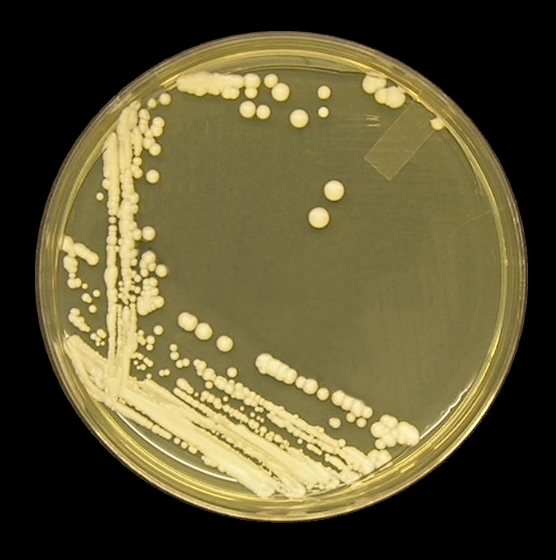What is Candida albicans?

Candida albicans is part of our natural microflora — or the microorganisms that commonly live in or on our bodies. It can be found in the GI tract, the mouth, and the vagina. Most of the time it causes no issues, but it’s possible for overgrowths and infections to happen.
Candida albicans is the most prevalent cause of fungal infections in people. Its species name, albicans, comes from the Latin word for “white.” The yeast appears white when cultured on a plate. And in the case of certain infections, like thrush, it can create white patches.
Types of Candida albicans infections
Below, we’ll look at the causes, symptoms, and treatment of four of the most common types of Candida infection.
Urinary yeast infection
Candida species are the most common cause of fungal urinary tract infections (UTIs). Candida UTIs can occur in the lower portion of the urinary tract or in some cases can ascend up to the kidneys.
The following can put you at risk of developing a Candida UTI:
- having taken a course of antibiotics
- having a medical device inserted, such as a urinary catheter
- diabetes
- a weakened immune system
Symptoms
Many people with a Candida UTI don’t have symptoms. If symptoms are present, they can include:
- an increased need to urinate
- a painful or burning sensation when urinating
- abdominal or pelvic pain
- blood in your urine
Treatment
Treatment is only recommended for symptomatic individuals. The antifungal drug fluconazole can be used in many cases.
Genital yeast infection
Candida albicans is the most common cause of genital yeast infections.
Normally, a type of bacteria called Lactobacillus keeps the amount of Candida in the genital area under control. However, when Lactobacillus levels are disrupted in some way, Candida can overgrow and cause an infection. You can also develop a Candida genital infection after engaging in certain sexual activities, particularly those that involve oral-genital contact.
Although otherwise healthy individuals can get genital Candida infections, the following groups are at an increased risk:
- people that have taken antibiotics recently
- people with uncontrolled diabetes
- immunosuppressed individuals
- pregnant women
- people that are taking oral contraceptives or who are on hormone therapy
Symptoms
Symptoms of a genital Candida infection can include:
- a burning feeling while having sex or while urinating
- an itchy or painful feeling in or around the vagina
- redness, irritation, or swelling around the vagina
- abnormal vaginal discharge that can be either watery, or thick and white
- lower abdominal pain
- a rash around the vagina
- a rash on the penis
Candida species can also infect the male genitals, often if their partner has a vaginal Candida infection. The infection may be asymptomatic, but can cause an itchy or burning rash around the head of the penis.
Treatment
Mild or moderate genital Candida infections can be treated with a short course of an over-the-counter (OTC) or prescription antifungal cream, pill, or suppository. You could also be prescribed a single dose of an oral antifungal medication, such as fluconazole. For more complicated infections, you may be prescribed a longer course of medication, either in the form of a cream, a pill, or an ointment.
Oral thrush
Despite being a normal part of the microflora of your mouth, Candida albicans can cause infections if it overgrows. The infection may not be limited to just your mouth. It can spread to your tonsils and the back of your throat as well. Severe infections may spread to the esophagus.

People that are at an increased risk for developing oral thrush include:
- those taking antibiotics or corticosteroid drugs
- someone with undiagnosed or uncontrolled diabetes
- immunosuppressed individuals
- those who wear dentures, particularly upper dentures
Symptoms
Some of the common symptoms of oral thrush include:
- white spots in your mouth that have the appearance of cottage cheese and may bleed when touched
- a burning or painful sensation in your mouth
- redness inside your mouth or at the corners of your mouth
- difficulty with eating or swallowing
- loss of taste
- a cotton-like feeling inside your mouth
If an oral thrush infection is left untreated, it can lead to a systemic Candida infection, particularly in people with a weakened immune system.
Treatment
Oral thrush is treated with an antifungal medication that can come in the form of a pill, liquid, or lozenge. Examples of drugs that are used include nystatin or clotrimazole.
Mucocutaneous candidiasis
Candida species can also infect your skin and mucus membranes. Candida albicans is most often the cause of a fungal skin infection, although other Candida strains can also cause it.
Areas that are warm, moist, or sweaty provide good environments for yeast to thrive. Examples of such areas include the armpits, groin, the skin between your fingers and toes, the corners of your mouth, and the area under your breasts.
Other risk factors for developing a Candida skin infection include:
- wearing tight or synthetic undergarments
- having poor hygiene or changing undergarments infrequently, including infrequent diaper changes for infants
- taking antibiotics or corticosteroid drugs
- having diabetes
- having a weakened immune system
Symptoms
The most common symptom of a Candida skin infection is a red rash that forms in the affected area. In some cases, blister-like lesions can form. The skin may also become thickened or produce a white substance that has a curd-like appearance.
Treatment
Antifungal creams are typically given to clear the skin infection. They can contain antifungal drugs such as clotrimazole, miconazole, and econazole. A steroid cream may also be given to help ease any itching or swelling. The skin should also be kept dry while recovering.
In cases where the infection is widespread, oral fluconazole pills may be prescribed.
Diagnosis of Candida infections
In order to diagnose candidiasis, your doctor will first take your medical history and ask you about your symptoms. They may also ask if you have any conditions or medications that could lead to a weakened immune system, or if you’ve taken a course of antibiotics recently.
Many common cases of candidiasis can often be diagnosed through a physical examination.

If your doctor is unsure if your symptoms are due to a Candida infection, a lab test will be requested and a sample taken from the affected area. This sample can then be used to culture the organism and to identify what species it is. Identifying the species of Candida that’s causing your infection is also helpful because your doctor will be able to prescribe an antifungal medication that will be effective in treating that particular species.
In summary, if you notice symptoms that are consistent with those of a Candida infection, visit your doctor in order to receive the proper diagnosis and treatment.

Great!
This is nice! I’m definitely going to share this knowledge with my friends!
Thank you. Please do.
I enjoyed reading this